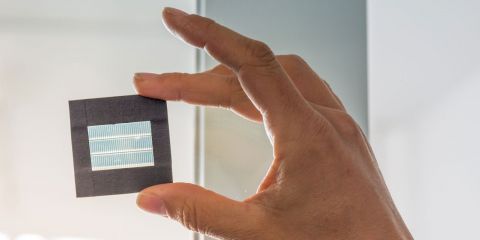Solution-Processed Photovoltaics
By harvesting the radiant energy that from the sun reaches our planet, solar photovoltaics is key to tackling the rising global energy demand as well as climate change. Whilst well-established solar cell technologies have reached high efficiency levels, the complexity of their manufacturing process, their materials properties, and their cost have thus far prevented solar photovoltaics from becoming ubiquitous and thus delivering its full benefits.
In recent years, lead-free perovskite-inspired materials have emerged as an attractive route to green, easy-to-fabricate photovoltaics that could potentially meet the demands for low-cost, ubiquitous solar energy harvesting. Whilst featuring attractive bulk properties similar to those of high-efficiency lead-halide counterparts, lead-free perovskite-inspired absorbers are not burdened with the toxicity of lead and, in many cases, possess much higher inherent stability. Moreover, in most instances, they can be deposited through low-temperature solution-based methods, which pave the way for low-cost photovoltaics.
In the Pecunia Research Group, we seek to harness lead-free perovskite derivatives into efficient photovoltaic devices. This involves firstly material development and characterization, through which we identify compositional, crystallographic, and microstructural solutions with high photovoltaic potential. Further, we engineer the deposition conditions and device architectures that maximize the resulting photovoltaic efficiency. Finally, we explore the capabilities of lead-free perovskite-inspired devices for photovoltaic applications that best allow them to express their full potential—in outdoor solar harvesting and beyond. This also involves demonstrating the capability of lead-free perovskite-inspired photovoltaic devices to address real-world applications, for instance, in regard to their use in self-powered electronics for the Internet of Things.

a) Photovoltaic efficiency boost in perovskite-inspired, solution-processed Rb3Sb2I9 devices through dedicated processing protocols that enhance the film microstructure (10.1039/C9TA13352F).
b) Photovoltaic enhancement of the cesium-antimony-halide system by tuning its crystallographic dimensionality via solution-based halide mixing (10.1016/j.apmt.2020.100637).
Representative Publications
V. Pecunia†, J. Zhao, C. Kim, B. R. Tuttle, J. Mei, F. Li, Y. Peng, T. Huq, R. L.Z. Hoye, N. D. Kelly, S. E. Dutton, K. Xia, J. MacManus-Driscoll, H. Sirringhaus, Assessing the Impact of Defects on Lead-Free Perovskite-Inspired Photovoltaics via Photoinduced Current Transient Spectroscopy, Advanced Energy Materials, 11, 22, 2003968, 2021. DOI: 10.1002/aenm.202003968
Y. Peng*, T. N. Huq*, J. Mei*, L. Portilla, R. A. Jagt, L. G. Occhipinti, J. L. MacManus-Driscoll, R. L. Z. Hoye†, V. Pecunia†, Lead-Free Perovskite-Inspired Absorbers for Indoor Photovoltaics, Advanced Energy Materials, 11, 1, 2002761, 2021. DOI: 10.1002/aenm.202002761
V. Pecunia†, L. G. Occhipinti†, A. Chakraborty, Y. Pan, Y. Peng, Lead-Free Halide Perovskite Photovoltaics: Challenges, Open Questions and Opportunities, APL Materials, 8(10), 100901, 2020. DOI: 10.1063/5.0022271
Y. Peng*, F. Li, Y. Wang, Y. Li, R. L.Z. Hoye, L. Feng, K. Xia, V. Pecunia†*, Enhanced photoconversion efficiency in cesium-antimony-halide perovskite derivatives by tuning crystallographic dimensionality, Applied Materials Today, 19, 100637, 2020. DOI: DOI: 10.1016/j.apmt.2020.100637
F. Li*, Y. Wang, K. Xia, R. L. Z. Hoye, V. Pecunia†*, Microstructural and Photoconversion Efficiency Enhancement of Compact Films of Lead-Free Perovskite Derivative Rb3Sb2I9, Journal of Materials Chemistry A, 8, 4396–4406, 2020. DOI: 10.1039/C9TA13352F






